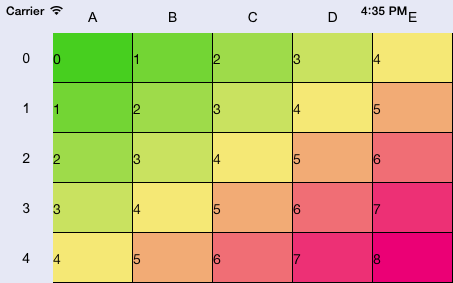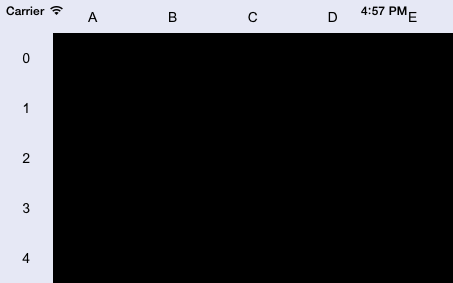
Operating system requirements: iOS 5.0 or later.
Mobile device: iPad.
This example describes the use of gradient for table cell conditional formatting. After starting the example the following operations are executed:
Minimum, medium and maximum values of table cells are set and removed.
The colors corresponding to minimum, medium and maximum cell values are set and removed.
The indicator of whether conditional formatting gradient is formed is set and removed.
It is set whether cell background color is determined based on row or column conditional formatting by means of gradient.
Executing the example requires to place the following code in the body of the executeExample method of the ViewController class (see the Creating a Simple Data Grid section):
// Get style of cell with the coordinate B1
NuGridCellStyle *style = [proxyDatasource gridView:[contr gridView] getStyleForCellInRow:1
column:1];
// Determine gradient colors
UIColor *redColor = [UIColor colorWithRed:0.94 green:0.43 blue:0.46 alpha:1];
UIColor *yellowColor = [UIColor colorWithRed:0.96 green:0.91 blue:0.46 alpha:1];
UIColor *greenColor = [UIColor colorWithRed:0.62 green:0.86 blue:0.29 alpha:1];
// Determine two color schemes
NSMutableArray *colorsTheme = [[NSMutableArray new] autorelease];
[colorsTheme addObject:@[redColor, yellowColor, greenColor]];
[colorsTheme addObject:@[greenColor, yellowColor, redColor]];
// Use the second color scheme
[style setGradientTag:1];
// Determine the number of rows
int rowCount = [datasource gridViewRowCount:[contr gridView]];
int columnNumber = 2;
// Determine array of column values
NSMutableArray *valueArray = [[NSMutableArray new] autorelease];
for (int i = 0; i < rowCount; ++i) {
NSObject *value = [datasource gridView:[contr gridView] valueForCellInRow:i inColumn:columnNumber];
[valueArray addObject:value];
if (valueArray.count > 0) {
// Sort array values
[valueArray sortUsingSelector:@selector(compare:)];
// Determine minimum, medium and maximum values
style.minGradValue = [[valueArray objectAtIndex:0] doubleValue];
style.midGradValue = [[valueArray objectAtIndex:valueArray.count / 2] doubleValue];
style.maxGradValue = [[valueArray lastObject] doubleValue];
}
}
// Specify that all gradient settings are determined
[style setIsGradientConfigured:YES];
//[style removeGradientTag]; // Defect
// Get color scheme
NSArray *colorArray = colorsTheme[[style gradientTag]];
/* Determine the colors corresponding to minimum, medium
and maximum values */
[style setMinColor:colorArray[0]];
[style setMidColor:colorArray[1]];
[style setMaxColor:colorArray[2]];
[style setGradientColumnBackground:YES];
[style setGradientRowBackground:YES];
// Apply created style
for (int i = 0; i < [datasource gridViewRowCount:[contr gridView]]; i++) {
for (int j = 0; j < [datasource gridViewColumnCount:[contr gridView]]; j++) {
[proxyDatasource gridView:[contr gridView] setStyle:style forCellInRow:i column:j];
}
}
After executing the example conditional formatting is applied to table cells with the use of gradient:

Remove the tag used for gradient formatting and the indicator whether gradient is formed, by adding the following code to the example:
NSLog(@"Conditional formatting tag before removal: %d", [style gradientTag]); // Remove the tag used for gradient formatting [style removeGradientTag]; NSLog(@"Conditional formatting tag after removal: %d", [style gradientTag]); // Remove whether conditional formatting gradient is formed [style removeIsGradientConfigured];
After executing the example the development environment console displays the conditional formatting tag before and after its removal:
Conditional formatting tag before removal: 1
Conditional formatting tag after removal: -1
The table is restored to its initial view:

The identical result is obtained if the colors corresponding to minimum, medium and maximum values of table cells are removed:
[style removeMinColor]; [style removeMidColor]; [style removeMaxColor];
Remove the minimum, medium and maximum values of table cells:
[style removeMinGradValue]; [style removeMidGradValue]; [style removeMaxGradValue];
After executing the example the cells are filled with black color:

See also: